3.3 /10 3 Votes
Voices of Gary King No. of series 11 First episode date 24 February 1989 Theme song Fun House Theme Tune Number of episodes 146 | 7.9/10 IMDb Created by Bob Synes Country of origin United Kingdom No. of episodes 146 Final episode date 29 December 1999 Program creator Bob Synes | |||||||||||||||||||||||||||||||||
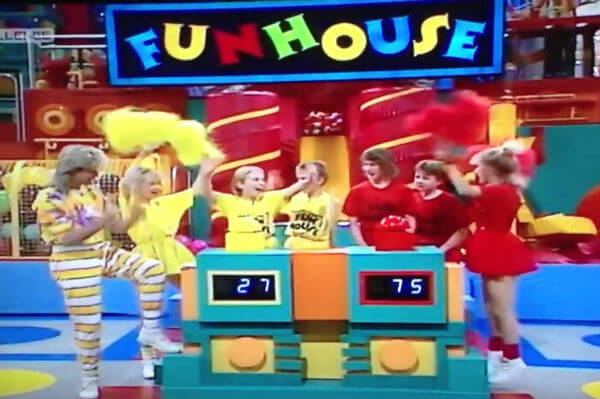 | ||||||||||||||||||||||||||||||||||
Similar Game show, Get Your Own Back, Knightmare, ZZZap!, Finders Keepers | ||||||||||||||||||||||||||||||||||
Fun house full episode 1997
Fun House was a British children's game show produced by Scottish Television and based on the American show, that aired on CITV from 24 February 1989 to 29 December 1999. It usually aired on Fridays (with the exception of Series 4, which aired on Wednesdays and Series 5 & 6, which aired on Thursdays). It was hosted by Pat Sharp, who was also aided by twin cheerleaders, Melanie Grant supporting the red team and Martina Grant supporting the yellow team. The announcer was Gary King. The theme tune was composed by David Pringle and Bob Heatlie.
Contents
- Fun house full episode 1997
- Fun house uk game show 1994
- Format
- Round 1 3 Messy Games
- 19891994
- 1995
- 19961997
- 19981999
- Round 3 The Fun House
- 19891993
- 1994
- 19951997
- 1998
- 1999
- Fun House obstacles
- References
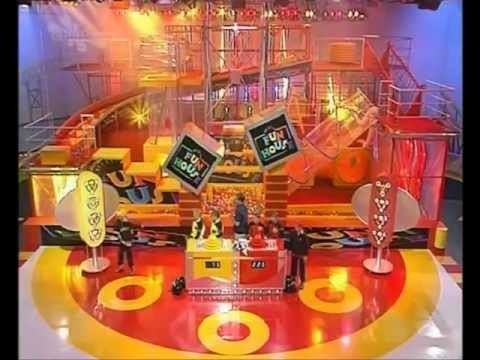
Fun house uk game show 1994
Format
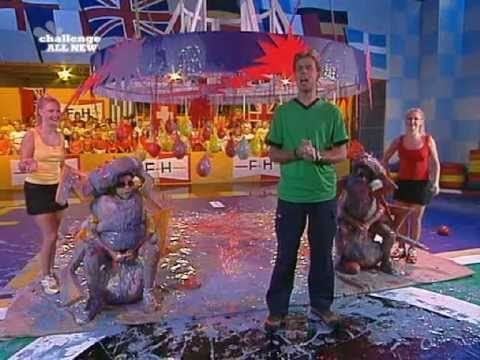
Each episode featured 2 teams each consisting of a boy and girl representing schools from around the UK. There were 3 rounds in each episode.
Round 1 (3 Messy Games)
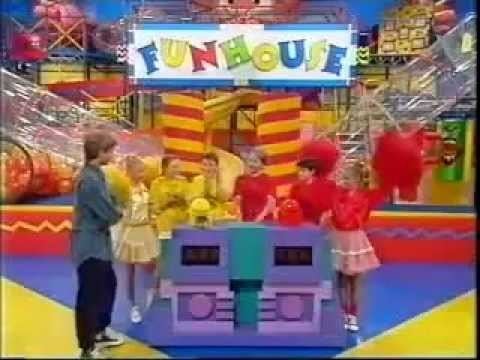
The opening games were referred to as messy games and typically used gunge as opposed to food. One game would be for the two boys, another game for the two girls and a third game for all four players, though the order would vary from episode to episode. In later series occasionally all games would be for all four players. From Series 1 to 2 the contestants were usually barefoot when playing some of the messy games, this was discontinued from Series 8 until the show's end. One of the three games would be a "key game", in which the losing team would get the same points as their score in that game.
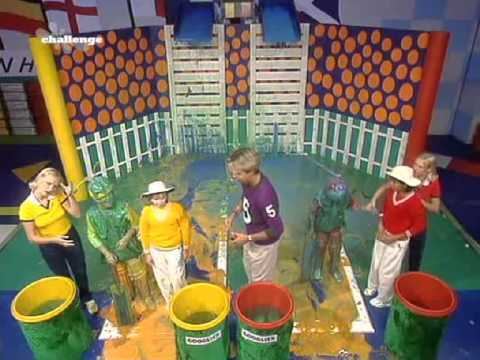
As in the original American version, a question would follow each game, to the value of 25 points if answered correctly.
1989–1994
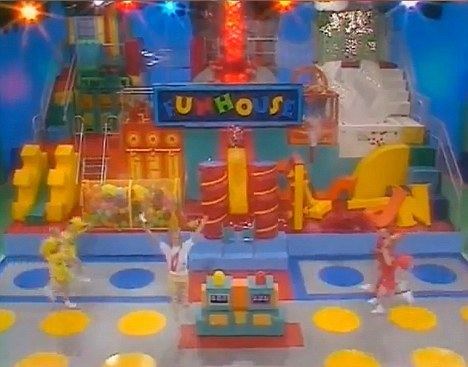
The Grand Prix was run in red and yellow coloured go-karts and lasted for two (later three) laps. Teams race round the track picking up tokens to add to their score, alternating drivers with each lap. The first lap was for "10" tokens for 10 points, the second for "25" tokens for 25 points, plus 25 points for winning the race. Tokens that ended up on the floor were null and void.
The tokens were later dropped into appropriately coloured boxes and added to the team's current score.
1995
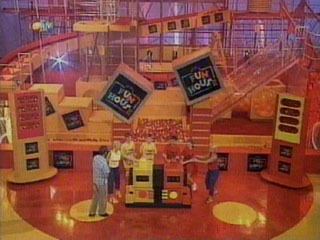
By 1995, the Grand Prix was extended to three laps and the numbered tokens were replaced with generic silver tokens with a blue stripe, and they were all worth 25 points. The winning team received 50 points and there was no driver changeover after the second lap.
The original format was revived in late 1995, but kept the third lap (which became a speed lap for 25 points, not 50) and the higher value tokens were collected first.
1996–1997
In 1996, tokens were replaced with buttons and the start of the race was similar in style to a regular Grand Prix race. There were buttons for 10 points and 25 points, pressed on alternate laps.
When it came to adding the points up, they were represented by a column of lights for the "10" buttons and the "25" buttons, and added to the team's score.
1998–1999
For the 1998 series, the buttons were replaced with wheels. There were four metal wires hanging above the track with all four steering wheels attached. There are four steering wheels for each team (valued at 25 points) bringing the maximum total points to 100. The first lap was a "power up" lap, the second lap was for the second team member to collect their first 2 wheels, The third lap was for the first team member to collect the second 2 wheels, The fourth lap was another power-up lap where the second team member has to win the race and collect an extra "50" points, (25 in 1999). Wheels dropped on the floor were not counted and neither were wheels collected on the first and final laps. The points were shown on the lights, this time representing the number of wheels collected, by Pat Sharp hitting the button on top of the team's podium. In 1999 the lights resembled the steering wheels. The results, as usual were then shown in numbers on the LED screen on the team's podium.
Round 3 (The Fun House)
In the UK version of the show, to actually win the power prize, they not only had to grab the tag, they also had to answer one question (often multi-parted) correctly within 10 seconds. Also, the only prizes in the Fun House were non-monetary because of a law in Europe stating that children cannot win money on game shows. The Fun House itself was completely different from the US version. In that version the Fun House itself was actually designed like a house, whereas in the UK version it was designed like a Funhouse ride that is often found at fairgrounds. When Gary King announced the prizes available there was originally video footage of the prize location shown with an inset for a photograph of the prize. From 1998 a diagram of the Fun House was shown with the prize location illuminated, and the inset still shown, when the prize was announced.
1989–1993
Much smaller but more colourful than later ones. It is almost entirely different from later versions.
1994
Much larger than the previous version and had a recurring theme of a bully (an inflatable figurine of such a person) in the Fun House, this included the inflatable bully at the back that was the same size as the Fun House.
1995–1997
The bully element has been removed from the show and the space previously occupied by the large bully figure at the back incorporated some flashing coloured lights and fake 'windows' to emphasise the 'house feel'. This was accompanied by colourful flashing studio lamps whereas the final run in previous series simply had the same studio lighting level that had been present throughout the entire episode.
1998
The Fun House has been completely re-built, but much based on the 1993–1997 version (although the big leap has changed from another tube slide to some giant steps). This included the Fun House being coloured of only red and yellow, instead of the multi-coloured Fun House used previously. The front entrance area has been completely re-designed. This included the removal of the "Fun House" logo hanging above the entrance and the removal of the two car-wash style spirals, being replaced by two stacks (one at either side) with blocks on top, each one having a Fun House logo on it. Also, this Fun House seems larger than the previous incarnations, and certain parts of it have been completely re-designed (the Snake Pit, for example, instead of simply being a multicoloured box with springy snakes inside, is now a more traditional snake basket.) Also, when Pat Sharp introduces the Fun House at the start of each episode, from now on, there are more explosions and firework bangs in the Fun House rather than simply two spark machines either side of the Fun House entrance logo. These "improved" explosions also included a few smoke machines to give a better impression of the special effects and along with sound effects throughout the teams 'run' through the fun-house added to the 'wackyness' and atmosphere. Also, a wall of stacked boxes was added at the entrance of the fun house after Gary King announced the episode's prizes, and the 1st player would plough through the wall to start the round when Pat said go.
1999
The final version was a slight re-designing of the Fun House. This included a change to the Big Leap from a tall fireman's pole leading to the giant steps to a zip-line seat built to carry the player from the top of the Fun House to the bottom ball pool.
Fun House obstacles
Series 1
Top Floor
Top to Middle Floor
Middle Floor
Middle to Bottom Floor A series of steps, ladders and slides Bottom Floor
Series 2
Series 3
Series 4
Series 4 saw a major redesign, and provided the most used layout. There were many additional ladders, and slides, not all of which had prizes attached to them. The entrance was straight into the ball pit which had three possible routes from it. To the left the balloon tunnel; to the right the monster maze; and straight ahead to go up to the raised middle platform.
Series 5
Series 6
Series 7
Series 8
Series 9
Series 10
Series 10 saw another redesign, although not quite so dramatic. Several elements were kept as were the major platforms. The Snake In The Box; Firemans Pole; Flying Fox; Ball Run; Climbing Net; A-Frame; Giant Steps; Danger Net; Crawl Tube; and WildSlide were untouched.
Series 11
